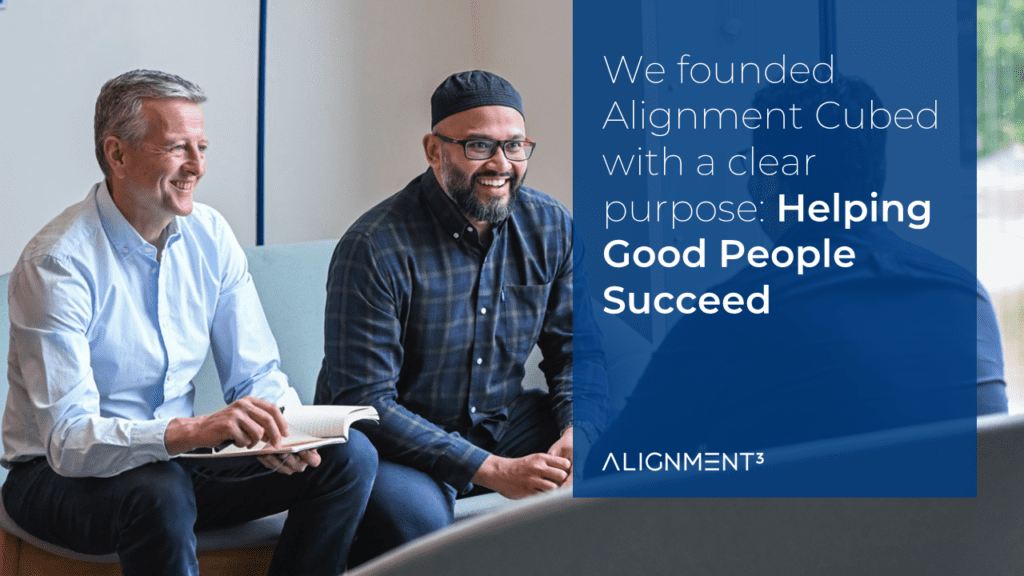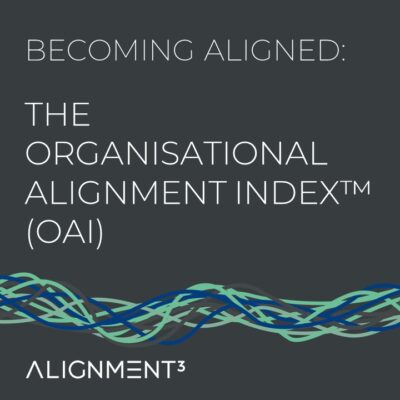We founded Alignment Cubed with a clear purpose: Helping Good People Succeed.

Our semi-autobiographical story
The contrast between the two organisations was stark. Despite having lots of successful leadership in larger organisations, why was I struggling to get the same traction here?
This biotech start-up had the makings to be great. That was the draw. Talented people. Promising tech. Potential to do societal good. But two months into this new role something was amiss, and I couldn’t put my finger on it. I tried to fix it as I had always done – optimizing processes, introducing best practices, and focusing on execution. But it didn’t work. No matter how much we tinkered with the mechanics of the company, the same problems kept cropping up.
Under pressure the leadership team struggled to reach unified decisions, power struggles emerged slowing decision-making, and project delivery was suffering. Employees felt overwhelmed and underutilised, losing motivation as miscommunication and competing priorities left them spinning their wheels. Teams, once excited by the work they were doing, became frustrated by changing priorities and leadership indecision.
Recurring issues weren’t just isolated problems – they were symptoms of something deeper. Why does this keep happening? What is it that is so different about this organisation?
You realise what you had when it’s gone
How had I not made the connection sooner? A decade of taking it for granted. It was just there, embedded in the DNA of the company. So natural that we never even talked about it. But now it was clear to me what was missing.
The realisation was both unsettling and exciting. Unsettling – because we weren’t just dealing with a few growing pains or operational hiccups. Exciting – because there was a clear way forward; a way to help not just the company but the people who work there and unlock their true potential by fixing what was fundamentally at the root of it all…
Alignment!
Once it became apparent what was missing, you could see misalignment everywhere, in every team, in every meeting. Departments acting in silos were moving in different directions, often unknowingly working at cross purposes. Leadership would issue inconsistent guidance and so teams struggled to execute because the vision wasn’t clear, the strategy was fragmented, and the day-to-day operations simply didn’t fit together. When leaders couldn’t articulate their vision simply and clearly, alignment became impossible, and their teams lost faith.
Our Insight
As we’ve worked independently across various companies, we’ve witnessed the story above repeat and it has become undeniable to us. Misalignment is the silent killer of organisational potential. The companies that succeed are not necessarily the ones with the best technology or the most funding. They are the ones where everyone—leadership, teams, and systems—are moving in the same direction.
At Alignment Cubed we’ve dug deeper into the latest organisational models and reflected on our experiences and critical insights have emerged:
- Forces of Misalignment Are Ever Present
We are innately misaligned and that’s without adding in any element of inevitable change. Whether hiring a new employee, launching a new product, evaluating a new market, responding to a customer need, or simply organisational entropy – each has the potential to bring misalignment. Neither your average MBA programme nor traditional job descriptions promote holistic thinking. Alignment belongs to nobody, so nobody does it. And so, misalignment silently derails your organisation. - The Pitfalls of Execution Without Clarity
We see countless companies rushing to execute without first clarifying their organisational context, identity, and vision of success. Without clear alignment at the leadership level, true psychological safety, and vulnerability-based trust, teams were left guessing. Projects stalled, momentum fizzled, and good ideas never saw the light of day. And so, misalignment kills innovation before it even started. - The Strategic Playing Field Is Changing
For decades, businesses relied on a common strategic approach focused on stability and independence. It worked. Leaders focused on efficiency, adopted best practices, and companies grew. But technology has changed the game. There’s a new world culture pulling toward agility and collaboration in which old, baked-in management systems of the past are no longer effective. And so, the opportunity for misalignment is greater than ever before. - The Hired Help Doesn’t Actually Help
Then came the consultants. Time and again, we watched as they’d be called in to offer solutions and fix symptoms without considering the bigger picture. Siloed solutions focus on only one piece of the puzzle in isolation and leave the rest of the system in disarray, or sophisticated frameworks are so complex that even the sharpest minds struggle to make sense of them. Lengthy reports got put in a drawer never to see the light of day again. And so, the misalignment continues.
Our Approach
These realisations led us to create Alignment Cubed™. We knew that tackling these challenges required a fresh approach – one that didn’t just treat the symptoms but addressed the root causes of misalignment and brought the power of alignment to the fore. We needed a process that could simplify the complexity while ensuring leadership cohesion and organisational clarity. That’s why we developed the Alignment Cubed Pathway™, a three-phase process designed to deliver immediate results and sustainable change. A process that involves building cohesive leadership teams, creating organisational clarity, and developing an execution architecture that ensures ongoing alignment.
The Stakes Are High
We’ve seen what happens when companies skip these steps: projects fail, good people leave, and momentum grinds to a halt. But we’ve also seen the magic that happens when teams become aligned: innovation flourishes, decisions are made faster, and people feel empowered to lead. Our process is simple but powerful and transforms organisations from disjointed operations into cohesive, high-performing teams.
This is our purpose: Helping Good People Succeed. We’ve been there, we’ve seen the pain, and we know what it takes to turn things around. It’s not just about aligning systems – it’s about aligning people, purpose, strategy, practices and process.
Are you ready to align? Take 20 minutes today to assess your company with our Organisational Alignment Index™ (OAI).
Back


